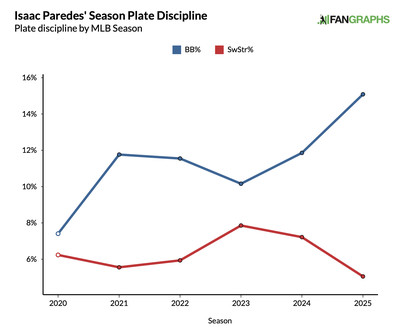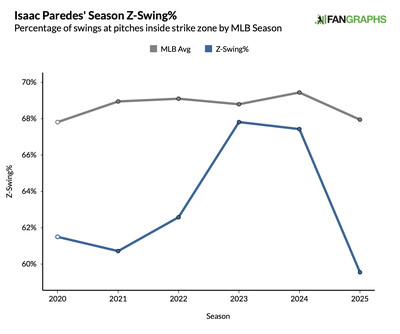
Adjustments happen all the time in baseball, and there is never just one particular kind of adjustment; it is more of a broad spectrum. Pitchers, for example, may add a new pitch or adjust the attributes of their existing arsenal. Sometimes it’s as simple as moving positions on the pitching rubber. Position players can also change their approach in various ways, both as a fielder and as a hitter. Some are subtle while others are blatantly obvious. There is a seemingly endless barrage of changes to account for, which is great for content but also daunting due to its sheer volume.
The great mystery when a player makes an adjustment is whether it will have any lasting effect, for better or worse. Not everything attempted will work out. Occasionally, a change that perhaps wasn’t given much thought completely alters a player’s outlook. Most of the time, I would venture, it is somewhere in between. For the Astros, at least among their hitters, Jeremy Peña has become the poster child of adjustments dating back to his rookie season in 2022. What he is doing at the plate this season deserves its own post. But, there is another hitter in Houston who has adjusted their approach, and they’re currently reaping the benefits: Isaac Paredes.
Generally, Paredes has been an above-average hitter for most of his career, with a wRC+ ranging from 115 to 136 since 2022. Apart from his brief and unproductive tenure with the Cubs, where he played for 52 games last season, there has been little reason to doubt his ability to hit well. We all figured, after the Astros acquired him as part of the return for Kyle Tucker, that Paredes would contribute to this lineup. However, the production, 42 games into his first season with the organization, has been better than expected, with a 141 wRC+ in 179 plate appearances.
Throughout his time with the Tigers, Rays, and Cubs, Paredes was never known as an extreme strikeout hitter. Frankly, strikeouts weren’t too much of an issue, with a career rate hovering around 17.1% entering this season. With the Astros, his strikeout rate has remained roughly the same as it has for much of his career, currently at 16.8%. But his walk rate has improved by a noticeable margin, up from 11.2% for his career to 15.1% for this season.

The Astros made it a point entering Spring Training to draw more pitches during their plate appearances, and they are achieving that goal, although they have improved only from 3.65 pitches per plate appearance in 2024 to 3.80 in 2025. Paredes’ inclusion in this lineup—he averages around 4.27 pitches per plate appearance for his career—has contributed to this goal. However, Paredes is still drawing nearly the same number of pitches this season as he has for his career. Instead, you can likely thank better swing decisions in general for this increased walk rate and improved offensive production. In fact, Paredes has become more selective at which pitches he swings at, especially inside the strike zone.

The better swing decisions extend to breaking pitches, with Paredes performing better against those pitches compared to last season (.561 SLG in 2025, .331 SLG in 2024). Against breaking in the strike zone, his production is remarkably improved, with a .714 slugging percentage this year compared to .443 last season. He’s also whiffing less against breaking pitches in the zone (14.9% to 11.9%). While those pitches weren’t a primary issue, this improvement has helped drive his strong start to the season. Four of his six home runs this season were against in-zone breaking pitches.
There is the question of whether these adjustments will remain in place in the long term. Pitchers will undoubtedly adjust. However, I am encouraged by the adjustments Paredes has implemented. Let’s see if he can continue at this pace.
Editor’s note:
Join the 1st Astros Crawfishboxes Podcast this Saturday at 4 PM. Just click THIS LINK.